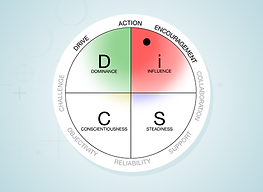
.png)

What are the reasons to switch?
What are the benefits of switching from DiSC Classic to Everything DiSC?
Discover how the DiSC model can help you understand your emotions and improve your communication skills. William Marston's book "The Emotions of Normal People" introduced the DiSC model, which is still used today. This model is depicted through a circle, known as the DiSC circle, utilized in Everything DiSC profiles. By understanding the foundation of the DiSC model, you can identify where you fit in and how you can improve your interchanges with others.

Unlock the power of DiSC Classic to gain insights into yourself and others! For decades, DiSC has been the go-to model for individuals seeking to understand personality types and behaviors. With continuous advancements in simplifying and refining the model, DiSC Classic has become the industry standard. Traditionally represented in a line-graph format, the DiSC model is widely used in Inscape Publishing products, including the DiSC Classic profile. However, there are various other ways to present your DiSC style, and our experts will help you choose the best format for your needs. Gain a deeper understanding of your unique personality and learn how to communicate more effectively with others using DiSC Classic today!

Have you ever heard of Everything DiSC? It's a simple and intuitive circular representation of DiSC that can give you much information about your DiSC style with just a glance. The angular location of your dot on the circle will reveal your primary DiSC style.
What's even more interesting is the distance from the dot to the center of the circle, which can give you additional insights into your DiSC style. If your dot is close to the outer edge of the circle, it suggests a solid dedication to your DiSC style, which is reinforced by the shading within the circle. It's also not uncommon to have a secondary DiSC style, so there's much to discover about yourself with Everything DiSC.

Everything DiSC is offering more advantage
1. Relationships
One of the most powerful aspects of the DiSC circle is that it allows us to show the relationship between two or more people in a straightforward, visual manner.
2. Adaptation & Stress
For years, consultants, coaches, and facilitators have used DiSC to help people recognize the occasional need to adapt their DiSC style to the people or situations around them. The Everything DiSC profiles use shading to help participants understand the areas on the DiSC map where they might have difficulty stretching or "flexing."
3. Integration Of The Four Styles
Instead of presenting the four DiSC styles as four separate traits, the circular model shows the true continuous nature of DiSC.
4. Memorability
Even though the line-graph representation of DiSC has proven to be incredibly powerful, the circular representation presents the DiSC model in an even more intuitive and memorable way without sacrificing the richness of information.
5. Group Dynamics
The circular representation of DiSC also allows participants to gauge their group's composition and see its implications quickly.
Everything DiSC sample graph

